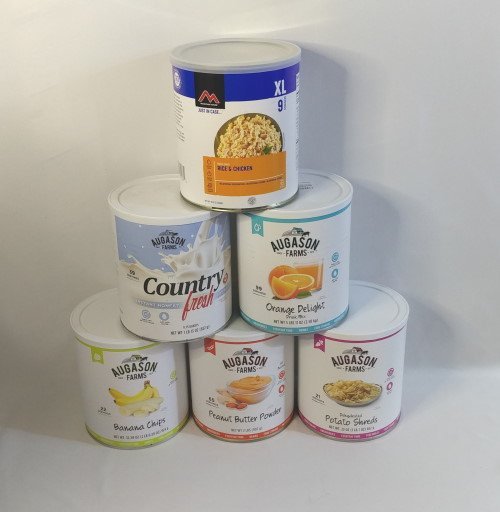Survival / Prepping JumpStart – Get Ready For Supply Shortages In A Hurry
Our bumpy future is becoming clear to more and more folks as inflation and empty spaces on store shelves become the norm. While some folks have been getting ready for years, there are many people who are starting now and want to get prepared as quickly as possible.
We have simplified all the research that goes into preparedness down to just a few solid choices for each topic so that you can do something today to move forward on your preparedness journey and then follow up later with more detailed research and training. Once you can cover all the categories below, then you’re off to a good start.
Water
The two main tools that you need for water are storage and filtration. Small-scale storage is just an extra trip to the grocery store or Costco to pick up some water bottles. The common, cheap water bottle is portable and disposable. They can be reused but are designed for a short lifespan. The common 32oz Nalgene is a better long-term choice for a refillable bottle. For a larger portable container, the Scepter Five Gallon Jerry Can is built like a tank and should last for many years. Larger scale storage typically involves 55-gallon plastic drums with a hand pump or large stackable containers with built-in faucets. Your local farm supply store can source larger storage tanks if you have the space. For filtration, the Big Berkey is commonly considered the best countertop unit, and a Sawyer MINI is a good, cost-effective portable filter.
Food
Food storage should start with an extra trip to the store to buy more of what you already eat, with a one-year or longer shelf life. This will get you the best bang for the buck and causes the least change to your diet. This can be supplemented with long-term storage type emergency food, but not all of this is anywhere near tasty. After some extensive taste testing of freeze-dried meals, two of the best options that our kids will eat without issue and are available in smaller quantities are Mountain House and Augason Farms. Mountain House has complete meals in a pouch that just require adding hot water. Augason Farms has a number of long shelf-life ingredients in #10 cans that really expand what you can cook without needing to run to the store. Having some of both on hand will cover a lot of ground. If you want to order months worth of food at a time, then Valley Food Storage has some good bulk options that we have tested before with good results. Check out our article on Modern Survival Food Options if you want to dig deeper into the topic. Set a goal of having enough food on hand for one month, then work up to wherever you feel comfortable. As long as you eventually eat what you buy, the current inflation rate makes extra food a better investment than cash stuffed under your mattress.
Create Fire
Cooking, boiling water, and a hot shower all require heat. The ability to get a fire going, whether lighting a stove or from a small stack of wood is one of the cornerstones of survival, as this one ability enables so many options. There are lots of fire-starting gizmos out there, but the BIC Lighter in an easy-to-find color is still the best bang for the buck. They are small, reasonably durable, and cheap enough to keep around in emergency bags, kitchen drawers, and backpack pockets. The Feuerstock ferro rod is the best backup fire starting option that we have found. There are many different ferro rods on the market, but this is the one that you would want to have on hand in a pinch. It has by far the best-bundled striker and the rod is large enough to be easy to use. For tinder, there are boxed options, but read up on how to find fatwood and the easy way to make char cloth for when the dryer lint runs out. Your backyard grill can obviously be used for cooking, as can a rocket stove or propane camp stove. The propane stove will be the closest to indoor cooking while the rocket stove can run off of twigs, pinecones, and other found bits of woody biomass.
First Aid & Medical
We have an entire article with a downloadable PDF guide on how to build your own First Aid Kit. But, if you want to skip the assembly and jump right to the end, then check out My Medic First Aid Kits like the MyFAK Pro. I had the chance to take a look at their products and chat with folks from the company at the last SHOT Show. One of the big advantages of My Medic is that their kits come with online training. Learning the skills to make the best use of your gear makes all the difference. Do not stop with just building or buying a medical kit and then hoping for the best. At a minimum, put some time into watching Stop The Bleed and CPR videos, then sign up for an in-person training course. Accidentally misusing basic medical supplies can actually make things worse.
Basic Tools
Keep a basic set of hand tools and an assortment of fasteners around. A bow saw is a good idea as well if there are trees in your area. Axes and chainsaws are awesome tools, but the time to learn how to use one is not when access to medical care is potentially a problem. Bow saws can certainly slice into your hand (done it) if you do not pay attention but are unlikely to try and remove legs or toes like their more aggressive brethren. Also, always have a good sharp knife handy. This could be a good folding knife like the Spyderco Delica in your pocket or a larger survival knife such as the ESEE-4. Sharp knives are safer than dull knives, so get a good knife sharpening kit like the Gatco or Work Sharp if you do not already have one, and start practicing on the dull kitchen knives that everyone has in a drawer.
Electrical
For electrical, the easiest place to start is a small solar setup with a folding panel, rechargeable battery bank, and USB lights. This will absolutely not keep your fridge running but will allow you to light up the kitchen, as well as recharge cell phones and batteries. This is a lot of capability on a smaller budget. If you want something turnkey that can run kitchen appliances, then this Bluetti solar system is a solid option. The LiFePO4 batteries and parallel panels are both serious upgrades from the next step down. The non-solar option would be a propane generator like the Alp with a few spare grill tanks on the back porch. Either way, keep some rechargeable Eneloop AA batteries on hand and a USB battery charger. This will keep your good AA flashlights running along with other small electronics. If EMP is a concern, then look into getting an EMP Shield for your home or car, as they pretty well have the market cornered on tested protection products for these kinds of events.
Communication
The simplest radio option is a battery-powered AM/FM weather radio that will let you listen to important local news. The C. Crane Skywave adds shortwave capability, which can pick up broadcasts from overseas. The Baofeng UV-5RA or GT-5R (whichever one is cheaper) will allow for local two-way communication if you put a few days into studying for and passing the Technician Amateur Radio license exam to stay legal. All the exam questions and answers can be found for free online. It is absolutely worth it to figure out how your radio works before you need it in a hurry.
Sanitation
Although this is not the most exciting survival subject, it is just as important as the rest. The ability to dispose of waste, get clean hands, and have a clean rear should not be overlooked. The Luggable Loo bucket toilet is a good starting point and a nice place to store plastic bags, TP, and hand sanitizer before it is needed. On a longer-term scale, organic matter can be composted. A small, two-compartment tumbling composter provides a way to dispose of solid waste so that it does not pile up and attract unwanted animals. For cleaning yourself up, baby wipes work on cracks and pits of all sizes and are an easy short-term solution. A solar camp shower can provide a warm water rinse-off option which is just amazing when you haven’t bathed for most of a week. If you are using natural soap, then the rinse water can be used to keep the garden growing. Also, make sure not to overlook the obvious and pick up toothbrushes, toothpaste, lady products, etc. when they go on sale at your local store.
Thermal Management
Dealing with temperature varies widely by region and time of year, so here are some general ideas. A wool blanket is the classic way to help stay warm when it cools off at night. Paired up with a tarp, this is a basic bedroll/shelter combo. Your camping gear can also be pulled out of the closet to camp in the middle of the living room and stay warm. A small fan can help move warm air in or out if you have electrical power. The core concept is to put on more clothes and do not get sweaty in order to warm up and stay hydrated in moving air in order to cool down. The main idea for this and all areas of preparedness is to not get fixated on making things perfect. A good plan executed today is better than a perfect plan attempted months in the future. Start taking steps today to get what you need and the training on how to use it most effectively.













